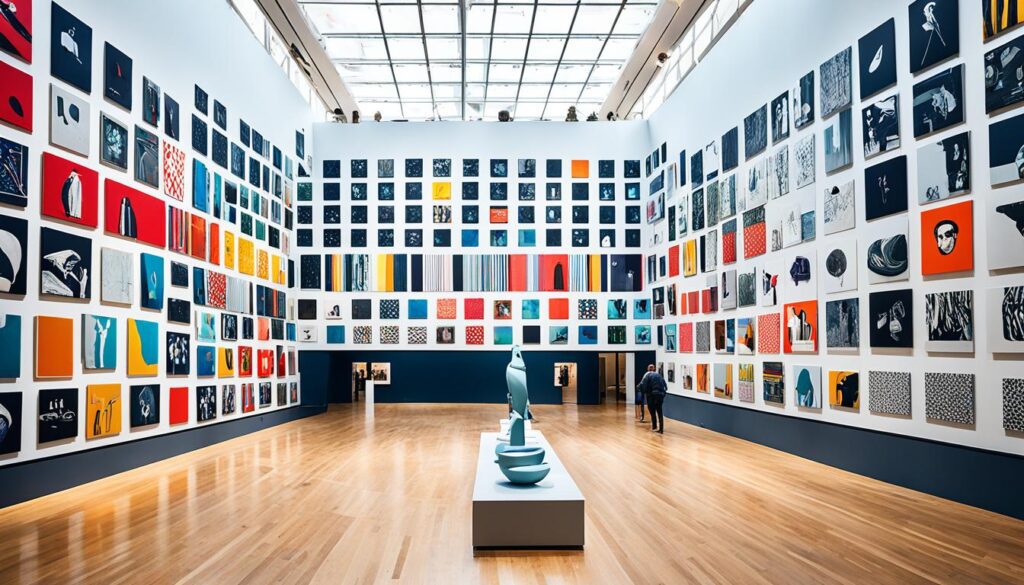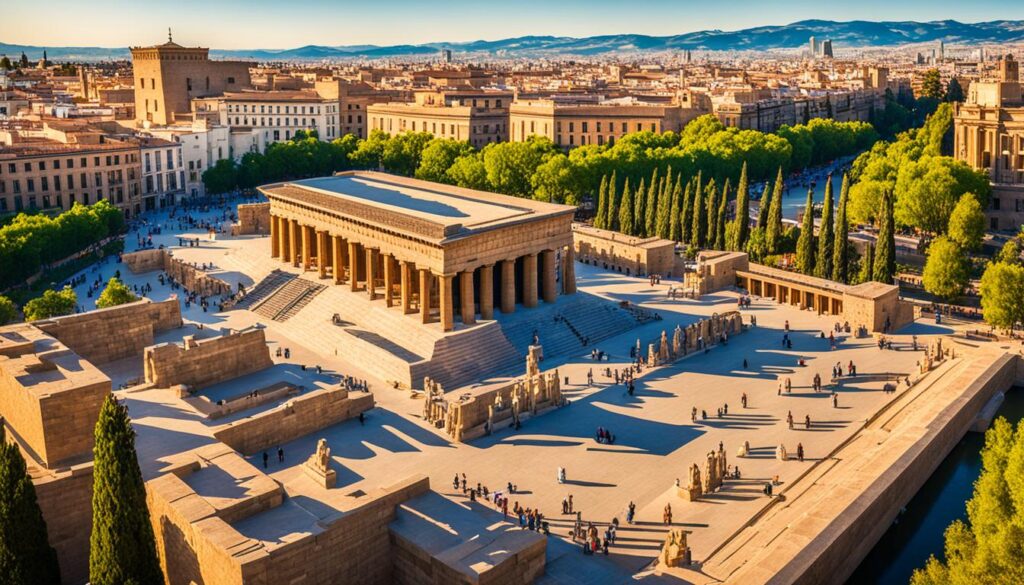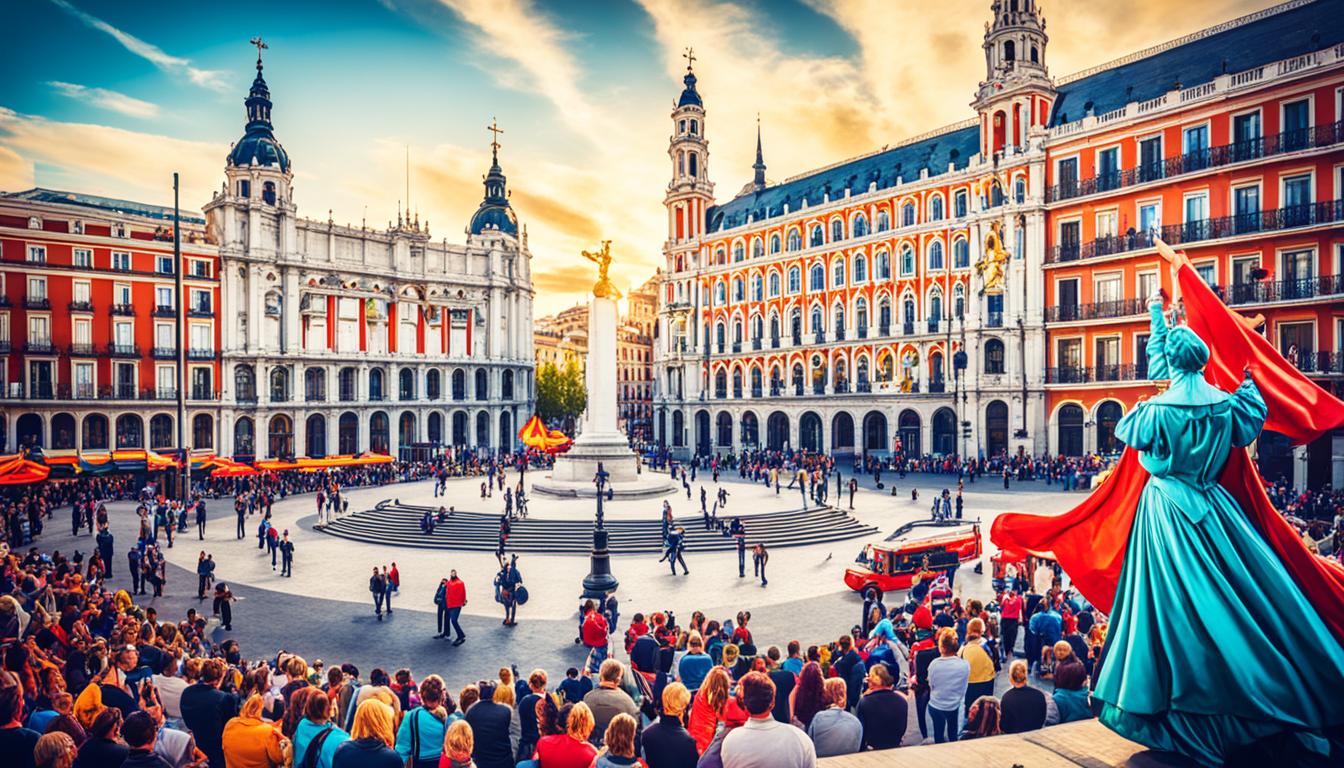Madrid is famous for its stunning architecture, historic sites, and cultural spots. It has everything from the grand Royal Palace to the lively Puerta del Sol square. This guide will take you through the best places in Madrid. You’ll learn about their history, design, and why they matter. It’s your key to an amazing trip through this lively city.
Key Takeaways
- Madrid is full of landmarks you can’t miss, from grand palaces and museums to historic squares and arches.
- The city’s landmarks show off a wide range of architecture, from Neoclassical to modern styles.
- Places like the Prado Museum and the Royal Palace are not just sights; they’re important to Madrid’s culture and history.
- Visiting Madrid’s landmarks lets you dive deep into the city’s lively culture and art scene.
- This guide gives you a full look at Madrid’s top landmarks. It helps you plan an unforgettable trip.
Gran Vía: Madrid’s Most Famous Street
Gran Vía stretches over 1.3 kilometers and is Madrid’s most iconic street. It started in 1910 and finished in 1929, linking Salamanca and Argüelles. The street’s architecture mixes Baroque, Beaux-Arts, and Art Deco styles. This makes it a stunning symbol of Madrid.
Historic Significance and Architecture
The Gran Vía was made to be a fancy shopping area, improve traffic, and be a leisure spot. By the early 1900s, Madrid had over 494,000 people, needing a new area. Over time, the street has changed a lot, affected by World War I, the post-war, and the post-Franco era.
The Edificio Telefónica is a key building on Gran Vía. It’s 124 meters tall with 13 floors and a central tower. Built in 1929, it was the Spanish telecom company’s HQ until 1986. It has six fancy foyers with over 500 decorations.
Shopping and Entertainment Hotspot
Gran Vía is also a top spot for shopping and fun in Madrid. It has many shops, from high-end to specialty stores. After shopping, people can enjoy the entertainment, like theaters, cinemas, and bars.
Even though fewer cinemas are left, Gran Vía still has a busy nightlife. People usually start their night around 10 pm and party till 6 am in summer.
The Metropolis Building is another highlight of Gran Vía. It’s known for its beautiful look and symbol status. The Iglesia de San José, a Baroque church from 1745, also adds to the area’s history.
In 2018, Madrid made Gran Vía and nearby areas pedestrian-friendly. This made it even more popular for shopping, entertainment, and sightseeing in Madrid.
Museo del Prado: Spain’s Premier Art Museum
In the heart of Madrid, the Museo del Prado is Spain’s top art museum. It showcases European art, especially Spanish masterpieces. The building started in 1785 for King Carlos III. It opened on November 10, 1819, for everyone to see.
The museum has works by famous artists like Diego Velázquez, Francisco de Goya, and Hieronymus Bosch. You can see Las Meninas by Velázquez and Goya’s Black Paintings. These are big draws. The Prado also has temporary shows to highlight its vast art collection.
Impressive Art Collection and Exhibitions
The Prado’s collection covers a lot of European art, focusing on Spanish art. You can see works by big names, including:
- Rubens
- El Greco
- Bruegel
- Dürer
- Raphael
- Caravaggio
- Rembrandt
- Velázquez
- Goya
Temporary exhibitions at the museum add to the experience. They show how art has changed and the many ways artists express themselves at the Museo del Prado.
“The Prado is a shrine to the great Spanish masters, a place of pilgrimage for art lovers from around the world.”
If you love art or just want to experience culture, the Museo del Prado in Madrid is a place you must visit. It honors the lasting impact of Spanish and European art.
Palacio Real (Royal Palace): Opulent Royal Residence
The Palacio Real, or Royal Palace, is a symbol of Spain’s rich royal history. This grand 18th-century building is the official home of the Spanish monarchy. Yet, it’s mostly a museum, letting visitors see its lavish rooms and learn about Spain’s past rulers.
Lavish Interior and Architectural Highlights
The Palacio Real has over 3,000 rooms, each filled with beautiful furniture, stunning chandeliers, and amazing architecture. The main staircase, by architect Sabatini, and the Throne Room are must-sees. They show the luxury and grandeur of the Spanish royal court.
Queen Isabella II and Alfonso XII redecorated the Real Cocina, the palace’s kitchens, from 1861 to 1880. This added to the palace’s beauty. Visitors can see these spaces and admire art by famous artists like Velázquez, Goya, and Sorolla.
Royal History and Guided Tours
The Palacio Real has a long history as the home of Spanish monarchs from Carlos III to Alfonso XIII. Each king and queen added their own style to the palace. Guided tours let visitors learn about the Spanish royal family and the palace’s role in Spanish history.
These tours also give skip-the-line access. This means visitors can quickly see the palace’s beautiful rooms and learn about its architecture. For example, the palace has a unique wrought-iron fence made in 1899 by Enrique Repullés Segarra.
For a full experience, consider the Royal Madrid Palace tour with tapas and a flamenco show. This 3-hour tour of the palace ends with a live flamenco performance at Torres Bermejas Tablao. It’s a great way to see Spain’s culture.
Parque del Retiro: Madrid’s Iconic Green Oasis
In the heart of Madrid lies the Parque del Retiro, a vast urban oasis. It has been a favorite spot for centuries. This park is Madrid’s largest green area, covering 125 hectares. It’s home to over 15,000 trees, creating a peaceful environment.
The park started with the Monasterio de los Jerónimos built by the Catholic Monarchs. Over time, it turned into a place for rest and fun. In 2021, it and the Paseo del Prado were named a UNESCO World Heritage Site. This shows the park’s great cultural and historical value.
Parque del Retiro offers beautiful gardens to explore. You can see the Jardín de Vivaces, Jardines de Cecilio Rodríguez, and Jardines del Arquitecto Herrero Palacios. There’s also the Palacio de Cristal, a beautiful glass and metal building from 1887, now hosting art shows.
The Retiro Lake is a highlight, a calm body of water up to 3 meters deep. Visitors can rent boats to see the park from a new view. The Monumento a Alfonso XII, a grand monument, looks over the lake. It has an observation deck with amazing views.
Looking for a quiet walk, a picnic, or diving into Madrid’s culture? The Parque del Retiro is the place to be. It shows Madrid’s love for green spaces, offering many outdoor activities and relaxation spots.
“El Retiro Park is a true oasis of serenity in the heart of Madrid, offering a peaceful respite from the bustling city streets.”
| Key Facts about Parque del Retiro | Details |
|---|---|
| Size | 125 hectares |
| Number of Trees | Over 15,000 |
| UNESCO World Heritage Site | Designated in 2021 |
| Prominent Features |
|
| Boat Rental Rates | Starting at €6 per half-hour |
Plaza Mayor: Historic Square and Cultural Hub
The Plaza Mayor in Madrid is a true gem. It has captivated visitors for centuries. This historic square dates back to the 15th century. It was once called the ‘Plaza del Arrabal’ before becoming one of Europe’s grandest squares.
The Plaza Mayor shows off Madrid’s architectural skills. It combines Spanish Herrerian and French neoclassical designs. At its center is a statue of King Philip III on horseback. This statue was made in 1616 by famous sculptors Jean Boulogne and Pietro Tacca.
Architectural Masterpieces and Events
Three-story buildings with over 200 balconies surround the plaza. They make a stunning visual experience. The Casa de la Panadería building is right in the plaza. It has frescoes of mythological figures, adding to the square’s culture.
- Plaza Mayor is a center for cultural events. It hosts the ‘Fiesta de San Isidro,’ Madrid’s biggest festival.
- The ‘Casa Botin’ restaurant is in the plaza. It’s claimed to be the world’s oldest eatery, dating back to 1725.
- Events like the Christmas Market in December and concerts during festivals like San Isidro happen here.
Recently, Plaza Mayor has been made more pedestrian-friendly. This has made it easier and more fun for visitors. The square is a symbol of Madrid’s history and evolution. It draws people from all over the world to enjoy its culture.
Museo Nacional Centro de Arte Reina Sofía: Contemporary Art Gem
Madrid’s Museo Nacional Centro de Arte Reina Sofía is a top spot for art lovers. It’s part of the city’s famous “Art Triangle.” Here, you’ll find a wide range of modern and contemporary art. This includes Pablo Picasso’s famous “Guernica.”
Picasso’s Guernica and Modern Art Exhibits
“Guernica” by Picasso is the museum’s highlight. It honors the tragic event in the Basque town during the Spanish Civil War. This huge painting shows the cruelty of war and Picasso’s incredible talent.
The museum also has works by famous Spanish artists like Salvador Dalí and Juan Gris. It features modern art and temporary shows with new works. This keeps the experience fresh and exciting for visitors.
The museum’s design matches its modern art with its own stunning architecture. The glass and steel towers add to the modern feel. A visit here is perfect for those wanting to dive into spanish modern art and madrid contemporary art museum.

“Painting is not made to decorate apartments. It is an instrument of war.”
– Pablo Picasso
Puerta de Alcalá: Madrid’s Triumphal Arch
High above Madrid’s busy streets, the Puerta de Alcalá is a key landmark. It shows off the city’s deep history and architectural beauty. Designed by Francesco Sabatini, an Italian architect, it was built for King Charles III in 1778. This makes it over 240 years old.
Neoclassical Architecture and Illuminations
The Puerta de Alcalá has a beautiful five-arched design. It has three big archways for carriages and two for walkers. It’s filled with detailed sculptures, engravings, and columns. At night, it lights up, showing off the Madrid’s historic monuments.
People can see the puerta de alcala madrid from Plaza de la Independencia or while walking in Retiro Park. Its stunning madrid neoclassical architecture and spot make it a top spot for visitors.
“The Puerta de Alcalá is a true architectural gem, a symbol of Madrid’s rich history and cultural identity.”
Through the years, the madrid triumphal arch has seen many big events, like battles with French troops in the 1800s. It’s been kept up well and was named a National Monument in 1976. This ensures it will be one of madrid’s illuminated landmarks for many years.
Templo de Debod: Ancient Egyptian Temple
In the heart of Madrid, the Templo de Debod is a unique sight. It’s the only fully preserved ancient Egyptian temple in Spain. Built 2,200 years ago in Aswan, Egypt, Spain got it as a thank you for helping with the Abu Simbel temples.
The move of the temple was an amazing feat. It was taken apart, then carried 3,862 kilometers to Madrid. There, it was put back together in Cuartel de la Montaña Park. Since 1972, it has been a popular spot for visitors.
Walking through the Templo de Debod, you’ll feel like you’re in ancient Egypt. You’ll see detailed carvings of gods Amun and Isis. The temple has many rooms, each telling a part of its long history.
Evening is the best time to see the Templo de Debod. The temple looks stunning against the Madrid skyline at sunset. It’s a moment you won’t forget, showing off the city’s history and culture.
“The Templo de Debod is a true gem of Madrid’s cultural landscape, a rare ancient Egyptian monument that has found a new home in the heart of this vibrant city.”
If you love history, architecture, or just want a special experience, don’t miss the Templo de Debod. Dive into its fascinating history and enjoy the amazing sunset views. This Egyptian temple in Madrid is a must-see.

Must-See Landmarks in Madrid: El Rastro Flea Market
No trip to Madrid is complete without visiting the lively El Rastro flea market. It’s a top spot for both locals and tourists. Every Sunday and on public holidays, over 1,000 vendors fill the streets around Plaza Cascorro. They offer everything from antiques to handmade crafts and clothing.
Vibrant Atmosphere and Unique Finds
El Rastro stretches through the La Latina neighborhood streets and squares. It’s full of unique items like artisan goods, vintage books, and home decor. The main area is Plaza de Cascorro, with stalls spreading out into Calle de San Cayetano and Plaza de General Vara del Rey.
With over 700 stalls and more than 100,000 visitors each weekend, El Rastro is always buzzing. The market gets really busy around 11 a.m. Bargaining is a big part of the experience, and you can often get items for 15-20% off.
After the market, check out the nearby tapas bars and eateries in La Latina. It’s a great way to complete your Madrid visit. El Rastro is perfect for finding unique souvenirs, vintage finds, or just enjoying the lively vibe. It’s a key part of Madrid’s culture and spirit.
Conclusion: Unforgettable Madrid Experiences
Madrid is a city full of history, stunning architecture, and vibrant culture. It’s a top spot for travelers. You’ll find the grand Royal Palace and the famous Prado Museum. Plus, there’s the beautiful Parque del Retiro and the iconic Puerta de Alcalá.
Exploring Madrid’s top sights lets you dive into its rich heritage. You’ll see why Madrid is so captivating. Imagine walking through the Palacio Real, enjoying Parque del Retiro, or experiencing the city’s lively atmosphere.
Madrid has something for everyone, from the busy Gran Vía to the art at the Museo Reina Sofía. It’s a city full of history, art, and food. By exploring Madrid, you’ll appreciate its legacy and spirit even more.

